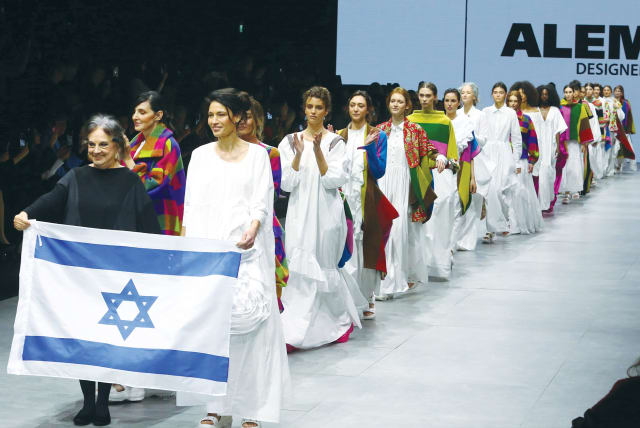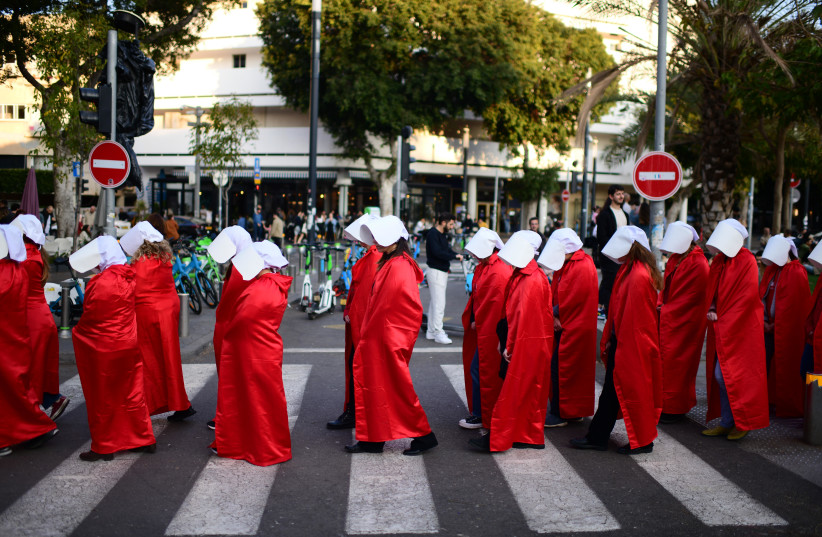My Word: Political statements and fashion statements

There was a long period around the Disengagement from Gaza in 2005 when wearing orange in Israel was a political statement. Is red now going to be associated with the anti-reform protests?
You can learn a lot from daytime TV. When I wanted a break while working from home last Thursday afternoon, I turned on the television. I was seeking something like an educational children’s program or a nature documentary. Instead, I found programming on human nature and the herd mentality. The main Israeli stations were broadcasting live from the Day of Disruption demonstrations that were taking place (yet again) to protest the government’s judicial reform initiative.
A news junkie by nature and profession, I nonetheless could not see the point in more live footage from an event where nothing much was happening – unless it was in hope of creating the conditions for something more dramatic. The images were similar to those on the nightly news and those broadcast live every Saturday night, ad nauseam.
The footage did, however, raise some questions. How did people know to turn out to the demonstrations wearing red, I wondered. There was a long period around the Disengagement from Gaza in 2005 when wearing orange in Israel was a political statement, the color of those demonstrating against the mass eviction of Jews from Gush Katif.
Is red now going to be associated with the anti-reform protests?
It turns out that I don’t mix in the right circles – or the correct WhatsApp groups. That’s why I didn’t get the memo of what the well-dressed woman protester is wearing. But what literally caught my eye was the bright red shirt worn by the KAN 11 reporter broadcasting from a protest by women in Tel Aviv. An experienced broadcaster would not have put that on by chance. She was showing her true colors, or at least identifying with the protesters as openly as possible. Her microphone was her megaphone.
I would never have considered putting on a green hat to interview the right-wing Women in Green or a black shirt to interview members of the left-wing Women in Black.
Undeniably, the award for the most striking protest dress code goes to the women taking part in Handmaids’ protests, dressed as characters from the dystopic The Handmaid’s Tale, wearing red capes and white bonnets. The socio-psychology behind the protests is fascinating. In an article which appeared in The Jerusalem Post Magazine last week, organizers and participants explained its origins and rationale.
The Handmaids are not allowed to look up and have to remain absolutely silent while wearing their protest outfits. “You really start to lose yourself – it’s an absolutely frightening experience,” said Merav Cohen-Mor, a strategic adviser and community organizer. “Some of the women who’ve joined us have been so overwhelmed by the experience and felt deep distress.”
So ultimately, the women are scaring themselves even more and then using that to justify scare tactics.
Most of these protesters have missed a significant clause in the proposed reform: It requires for there to be at least two women on the committee that selects judges (not including the head of the Supreme Court or the chair of the Knesset Constitution, Law and Justice Committee, if they happen to be women.) Currently, there is no requirement for women to be included on the selection panel.
The scaremongering is over the top, but evidently effective. “I don’t want to have to end up wearing a burqa because of the reform,” a friend shouted at me this week in what passes for debate nowadays. The fact that the burqa is never going to be a dress requirement in the Jewish state – unlike in Islamic countries – is obviously irrelevant if you want to try to create the false narrative that Israel is going to rival Iran when it comes to women’s rights.
Interestingly enough, the anti-reform camp never considers that the opposite phenomenon could occur in a state where the secular court has taken upon itself to have the last word in determining the country’s colors. What if a largely secular coalition in the future were to pass a law banning religious head-coverings in public offices?
How absurd does that seem?
Not very if you consider the laws in France, for example. A year ago, France’s highest court even upheld the ban on lawyers wearing a hijab in the courtroom, knocking down an appeal by a religious Muslim lawyer. And in December, Israeli immunologist Dr. Cyrille Cohen was challenged by a (Jewish) journalist during a television interview on French TV about wearing his kippah in the studio.
Altogether, recent experience has proven that I can’t rely on French TV for escapism. France is being rocked by protests worse than Israel’s after President Emmanuel Macron continued to push ahead with his massively unpopular plan to raise the pension age from 62 to 64. Realizing that the plan, though economically sound, would not be able to pass in parliament, Macron circumvented normal legislative procedure to further it and he has remained defiant in the face of the mass demonstrations and riots. Mind you, he has reportedly warned Prime Minister Benjamin Netanyahu of the dangers to democracy presented by the judicial reform.
The Israeli demonstrations are, at least, diverse and colorful. “Grandmothers marching for Democracy” added a silver tint to the protests on Wednesday. The most bizarre image I have come across was a photo of a group of men at a protest in Tel Aviv last month holding placards with the slogan: “Daddy, where will you be when I’m banned from an abortion?” It turns out it was part of a satire show. It’s good to have something to laugh at.
Bringing the topic of abortion rights into the protests (especially combined with trans rights) adds to the foreign feel that dominates many of the mass rallies, with their omnipresent fist symbol and “Resist” slogan in English. Yet again, this week I wondered who was financing the expensive anti-government campaign.
Never averse to controversy, it was no surprise that this year’s Kornit Tel Aviv Fashion Week was as much a political statement as a fashion statement. Models – some all dressed up and others wearing very little – paraded on the catwalk carrying, or wearing, fashionable slogans.
There was a lot more fashion sense than commonsense on display. Among the standouts were singer-songwriter Ivri Lider, who wore a blue gown, a peculiar gold crown made of inverted courtroom gavels, and the words “Free in our land,” from Hatikvah, written across his chest. (He should stick to making great music as a form of expression.) Lihi Lapid, wife of opposition leader Yair Lapid, walked the catwalk in an outfit of many layers designed by 12 designers – symbolizing the Twelve Tribes – and former Meretz party leader Zehava Galon, paraded in a colorful maxi whose pattern included portraits of Supreme Court President Esther Hayut and Attorney-General Gali Baharav-Miara.
The Israeli flag was also widely featured. But for all the talk of diversity, it was clear that the Right and religious were not welcome. The flag, like the color red, has been adopted to serve the anti-government cause.
While some were dressing up for the protests, others were threatening to take off their uniforms. Reserve pilots and soldiers, mainly from elite units, continued their campaign refusing to train, dragging the IDF into a battle where it has no place to be. Damage has already been done. Israel’s many enemies, including in terrorist organizations Hamas and Hezbollah, are openly relishing watching Israel’s internal rifts tearing the country apart.
Maybe because last Thursday’s protests passed too peacefully to make good TV viewing, this week the Day of National Paralysis – an upgrade from a Day of Disruption – was scheduled to include protests in the ultra-Orthodox city of Bnei Brak.
Writing this column on Wednesday, I don’t know what will happen but I can predict that there is no happy ending to demonstrations which are forced to ratchet up the provocations each week for the purposes of ratings.
I hope the divisiveness goes out of fashion soon. I’m looking forward to watching something more palatable, like a leopard ripping apart its prey in a David Attenborough documentary. Enough with the human dog eating dog. It’s going to be hard enough for families and guests to keep the conversation civil at Seder night in two weeks, I don’t want to have to worry about what color I can wear.
liat@jpost.com
Jerusalem Post Store
`; document.getElementById("linkPremium").innerHTML = cont; var divWithLink = document.getElementById("premium-link"); if (divWithLink !== null && divWithLink !== 'undefined') { divWithLink.style.border = "solid 1px #cb0f3e"; divWithLink.style.textAlign = "center"; divWithLink.style.marginBottom = "15px"; divWithLink.style.marginTop = "15px"; divWithLink.style.width = "100%"; divWithLink.style.backgroundColor = "#122952"; divWithLink.style.color = "#ffffff"; divWithLink.style.lineHeight = "1.5"; } } (function (v, i) { });

